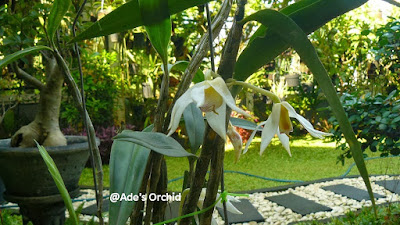Dendrobium lacteum is found in Papua and New Guinea. It grows on smooth barked tree trunks or on small branches near watercourses and swamps at elevations of 40 to 900 meters above sea level.
Dendrobium lacteum also called as The Milk-White Dendrobium, Dendrobium coxii, Dendrobium purissimum, Dendrobium purissimum, Dendrobium quinarium, Euphlebium lacteum, is a species of the genus Dendrobium. This species was described by Friedrich Fritz Wilhelm Ludwig Kraenzlin in 1894.
IDENTIFY DENDROBIUM LACTEUM ORCHID PLANT
Dendrobium lacteum is found in Papua and New Guinea. It grows on smooth barked tree trunks or on small branches near watercourses and swamps at elevations of 40 to 900 meters above sea level.
It is a medium to large sized, hot to warm growing epiphyte with club shaped, 20 cm long pseudobulbs that have reed like bases carrying a few, stalked, papery, pointed leaves.
The Milk-White Dendrobium blooms in the mid summer through early winter from a short, axillary, 2 to 3 flowered inflorescence that arise from the oval bract on a node near the apex of the canes and has a short lived flower, most often only for a single day. The flowers are white, the labellum being lightly striped with brownish red.
DENDROBIUM LACTEUM ORCHID PLANT CARE AND CULTURE
Cultural information should only be used as a guide, and should be to be adapted to suit you. Your physical location; where you grow your plants, how much time you have to devote to their care, and many other factors, will need to be taken into account. Only then can you decide on the cultural methods that best suit you and your plants.
Light:
Dendrobium lacteum do best in full sunshine (25000-50000 lux), close to the glass where glasshouse treatment is required. In addition to the natural light, you will have to use artificial light lamps.
Temperature:
The average temperature of the summer day is 25-26 ° C, night 21 ° C, giving a daily difference of 4-6 ° C. In winter, the average day temperature is 27-30 ° C, night 16-17 ° C, giving a daily difference of 13 ° C.
Humidity:
From summer to autumn, The Milk-White Dendrobium need the humidity of 80-85%, but for most of the remaining period it drops to 60-70%. Too dry air has a negative effect on the development of the plant: its growth is inhibited, and the leaves begin to turn yellow and dry out. The higher temperature, the higher the humidity should be, and the higher the humidity, the more often and longer it is necessary to ventilate the room where the plants are contained, otherwise the probability of rotting and various kinds of fungal diseases.
Substrate, growing media and repotting:
Dendrobium lacteum grows best in pots with staghorn peat as substrate (crocks and charcoal at the bottom of the pot). After potting, keep the plant in a cool, shady place for a few days before placing it in its growing position. Do not overpot. Use the smallest pot that will accommodate your plant.
It does not need frequent repot, therefore, it is desirable to transplant only when it is really necessary, for example, in cases of strong salinization or compaction of the substrate, at its critically high or low pH (the norm is from 5.5 to 6.5) or when the plant grows very strongly and the pot becomes cramped to it (pseudobulbs begin to hang from the edges of the pot). Repotting is best done immediately after flowering when new roots and new growth begin to grow.
Watering:
The Milk-White Dendrobium will require heavy watering until well into the Autumn, the plants then being allowed to dry out for the Winter, except for a soaking about once in four to six weeks. Watering is directly dependent on the temperature of the content, the higher it is, the more often it needs to be watered. When watering, excess water should flow freely from the pot, since stagnation of water both inside the pot and in its pan can very quickly lead to rotting of the roots and the lower part of the plant.
Fertilizer:
It is recommended to use a 1/4-1/2 dose of orchid fertilizer weekly. You can use the balanced fertilizer throughout the year or from spring to mid-summer use high-nitrogen fertilizer, and then until the end of autumn high-phosphoric fertilizer to stimulate flowering.
Rest period:
Dendrobium lacteum need less water in the winter, especially if they grow under the conditions of a dark, short day that occurs at moderate latitudes. They should dry somewhat between waterings, but they should not be dry for a longer period. Frequent morning fogging and rare, economical watering should allow the plant to go through a dry period of rest, while providing it with sufficient humidity. Fertilization should be reduced or eliminated until new growths appear and a more abundant spring watering begins.















COMMENTS